The European territory of the country in the winter season is subject to sometimes significant temperature fluctuations, from severe frost to thaw, from ice rains to heavy snowfalls.
The deposition of abundant snow deposits can provoke the descent from the roofs of houses of snow caps, which is dangerous for the possibility of harming the life and health of residents. Installation on the roof of snow holders will help to avoid various troubles and protect you from danger.
Snegozaderzhateli for metal roofs are an excellent tool to avoid the unexpected collapse of the roof of ice and snow cover masses.
Assignment of snow roofs from metal roofing:
- preventing the unexpected convergence of snow-ice masses from the roof;
- protection from flying down elements of the roof at a time of windy weather or during repair works of the roof;
- obstacle to clogging of drainage systems;
- prevention of damage to the facade walls of the house by rolling icicles and snow masses.
Classification of types of snow chains for metal roofing. Snow holders are of the following types: throughput and barrier.
Passing snegozaderzhateli more effective when delaying snow massifs of large volume and height. Snegozaderzhateli access type fragmentarily crush the snow cover.
Barrier snow holders are more suitable for habitats with climatic precipitation of a rare periodicity. Due to barrier snow holders, the snow-ice mass remains on the roof and in the sunny weather its active thawing occurs.
Snow covers for metal tiles are classified according to the following types:
- tubular;
- latticed;
- log-like shape;
- snow-retaining corner;
- snow retarder.
Structural features and operation of various types of snow holders for metal roofing.
Tubular snow holders. Tubular snegozaderzhateli - snegozaderzhateli in the form of a pipe, laid parallel to the roof. This construction is one of the most reliable, withstanding the pressure of snow strata. Tubular snow holders are fixed on the roof in places where the bearing wall and roof are connected. The material for their manufacture is galvanized steel, and on top they are painted with paint.
The product is reliable and resistant to corrosion. Tubular snow holders, selected by the color of the roof, are practically invisible and do not discord with the color of the tile. The advantage of these products is that they can be fastened to the roof when assembling it, as well as to the roof used during the time.
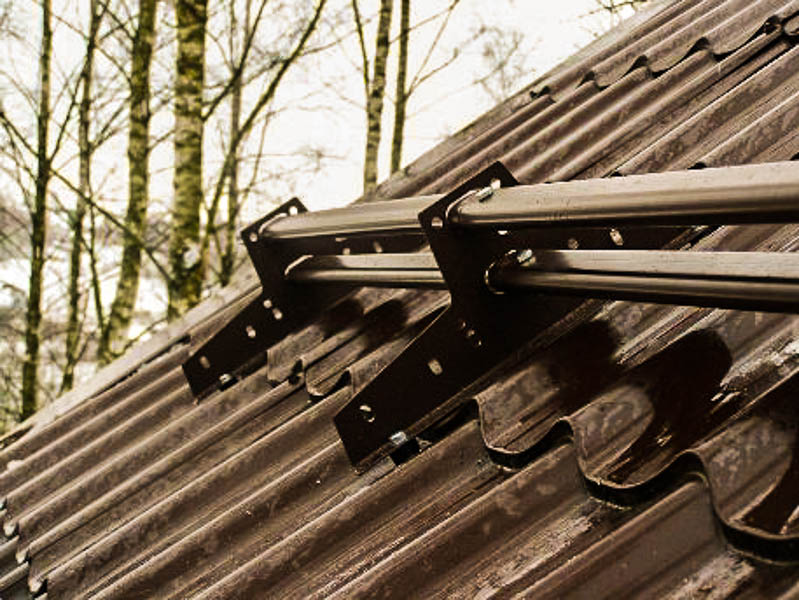 Snow retention brackets for metal roof tiles. The most famous and popular snow chains. They represent a device in the form of a grid lattice. The design solution of snow chains increases the area of counteraction to the masses of snow and ice, despite the degree of inclination of the roof and the steepness of its slope.
Snow retention brackets for metal roof tiles. The most famous and popular snow chains. They represent a device in the form of a grid lattice. The design solution of snow chains increases the area of counteraction to the masses of snow and ice, despite the degree of inclination of the roof and the steepness of its slope.
Logs with snow chains. This is the oldest kind of snow-holders. They were used in the past centuries in the Alpine mountains. Timber snow chains in the modern form rarely look like wooden logs. Log snow retention now - this is a pipe, which is 140 mm across, made of metal. Reliability is the main advantage of log snow holders. The main advantage of log snow-holders. The wide diameter of the pipe allows to withstand considerable loads, reliably keeping the snow at the same time.
Snow-holders on metal in the form of a snow-retaining corner. The name of the device speaks about their form. They are made of sheet steel. The simplicity of the design does not interfere with providing good reliability against the descent from the roof of ice-and-snow masses. A ruler of colors of a covering of corners allows to pick up an optimum combination of a shade of corners and directly a roof.
Snow-retaining corners are attached to the roof by means of simple corners and self-tapping screws. Among the entire range of snegozadderzhateley this is the most budget option for the price. The installation of such snegozadderzhatel is simple enough and it can be done independently. The corner should be attached to the upper wave of the sheet metal. For greater efficiency of snow retention, it is proposed to use the chess order of fixing the corners to the roof.
 Snow-holders for metal-tile auxiliary. A typical type of snow-retaining elements is the snow retarding snowstorm or snowstopper. Snagstoppery mounted in addition to other snow-retaining elements: tubular, lattice, corners. The main disadvantage of snegstoppers is their small height, but in combination with the basic snow-retaining elements this defect is leveled. Snagstoppery must be mounted parallel to the cornice with a uniform distribution of them along the entire perimeter of the roof, at a distance of up to 80 centimeters from the edge of the roof.
Snow-holders for metal-tile auxiliary. A typical type of snow-retaining elements is the snow retarding snowstorm or snowstopper. Snagstoppery mounted in addition to other snow-retaining elements: tubular, lattice, corners. The main disadvantage of snegstoppers is their small height, but in combination with the basic snow-retaining elements this defect is leveled. Snagstoppery must be mounted parallel to the cornice with a uniform distribution of them along the entire perimeter of the roof, at a distance of up to 80 centimeters from the edge of the roof.
When choosing snegozaderzhateley should be guided by the climatic conditions in the places of residence, as well as the features of the roofing material, from which the roof is made, as well as the length and degree of the roof slope. With a steep roof, the installation of snegozaderzhateley should be carried out in several rows along the entire perimeter of the roof.
 The price range of snow chains of various types varies from 890 to 3000 rubles. The spread of prices for corner snow-holders is from 50 to 200 rubles, the cost of a snowstopper is from 50 rubles per piece.
The price range of snow chains of various types varies from 890 to 3000 rubles. The spread of prices for corner snow-holders is from 50 to 200 rubles, the cost of a snowstopper is from 50 rubles per piece.
Prices for snow chains are formed based on its type, country of origin and material of manufacture.
Snegozaderzhateli are an essential element of the roof, especially in areas with heavy snowfalls. Snegozaderzhateli provide the necessary level of safety in the winter and, accordingly, your comfort and sense of security.
The climate of most of Russia is famous for its frosty, snowy winters; therefore, our people have developed a special attitude towards the cold. Therefore, snow is an indispensable participant in children's games and winter fun. However, the snow may not be so harmless, especially the code flies from the roof to your head. Unorganized, avalanche-like dumping of snow masses from roofing ramps often causes injuries, injuries, damage to cars parked nearby and blockages in driveways. An integrated solution to these problems is the installation of snow chains.
Roofs of metal tiles are particularly in need of installation of snow retention elements, since the smooth surface of the ramps facilitates the slipping of the snow cap. The ice crust, formed by heating the bottom surface of the profiled sheet with warm air, leaves deep scratches on it when leaving it. In damaged areas, where the protective galvanic layer is broken, foci of corrosion appear. To premature failure and leakage of the roof, use snegozaderzhateli, working on the following principles:
Important! Selection of devices for snow retention is performed taking into account three criteria: the amount of precipitation in the winter, the angle of the slope and the roofing. When choosing snow-holders for metal-tile, pay attention to models that work on the principle of snow-cutting. Due to the fact that snow itself is safely retracted from the roof, you can not be afraid to leave it without cleaning, even in heavy snowfalls.
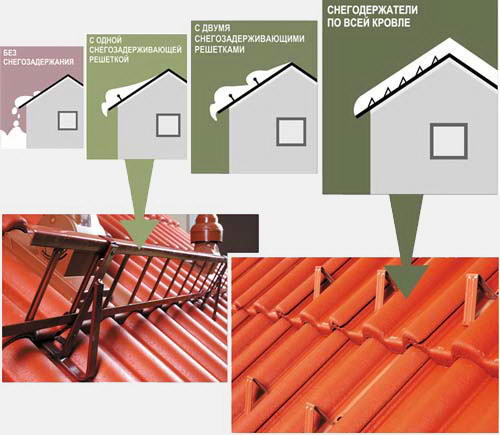
Types of Snow Holders
Snow-holders for metal-tile are produced in the form of snow blocks and snow-penetrating structures. They are made of strong, high-quality metal, as each element undergoes significant loads. The most popular types of snow retention elements are:

Important! The cost of one or a lattice construction of 3 m length is 1000-1500 rubles, which can negatively affect the family budget of the landlord. To save elements to protect against the descent of snow is established only over the places where the meeting is most uncomfortable: over the porch, paths, parking.
Installation
The installation of snow retention elements is planned during the design of the roof, as they increase the snow load on the rafter frame and foundation. In advance, you need to decide on the design and operation of the devices, as some of them require special conditions. By itself, the installation is quite simple and is done by one's own hands in the following order:
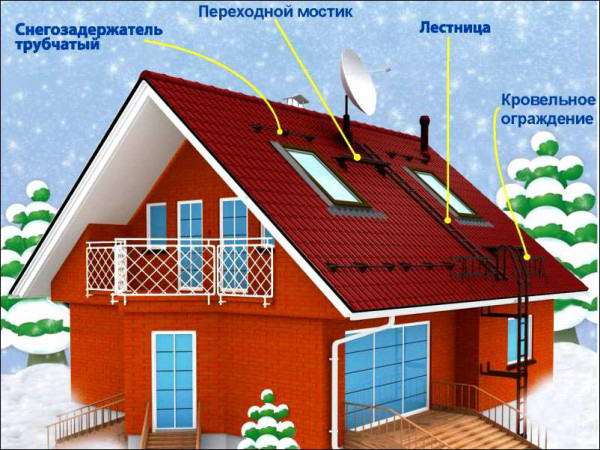
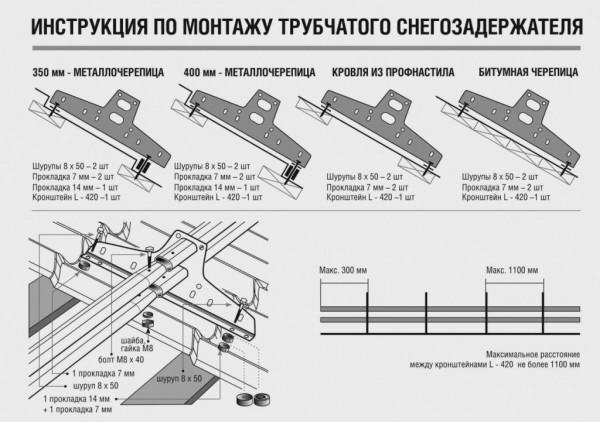
Note! Usually, one row of tubular devices is sufficient to contain snow masses on the roof. But if the amount of precipitation in winter in the area where construction is conducted is more than average, and the length of the ramp is more than 5 m, professional roofers recommend installing an additional row that reduces the rate of snow falling.
Video instruction
Modern metal roofs should be practical, durable and aesthetically attractive. In winter, it's safe. To fulfill the latter requirement, snow compressors are often mounted on metal roofing - special constructive solutions that ensure a safe precipitation, including snow. The same solutions level the risk of deforming the roof, which often happens under a large mass of snow and icing.
In real life, the mass of snow is often the weight of the roofing material itself, therefore, to eliminate the load from precipitation is a task of prime importance. Experts advise even at the stage of calculating the foundation to provide a snow holder in the construction of the roof. Professionals know that the safety of the upper part of the house largely depends on the mass of precipitation that falls on its surface.

The elements on the market are bribed by their diversity. The owner will have to find out on his own which decisions will be optimal in each specific case, and also how to properly install them for maximum security at home. The main functions of these solutions are:
- The probability of an independent convergence of the snow cap is leveled.
- The risk of unintentional clogging of the drainage system is eliminated.
- At times, it is easier to clean the roof of ice and sleet.
- Properly installed snow holder will not allow the falling snow and icicles to damage the facade.
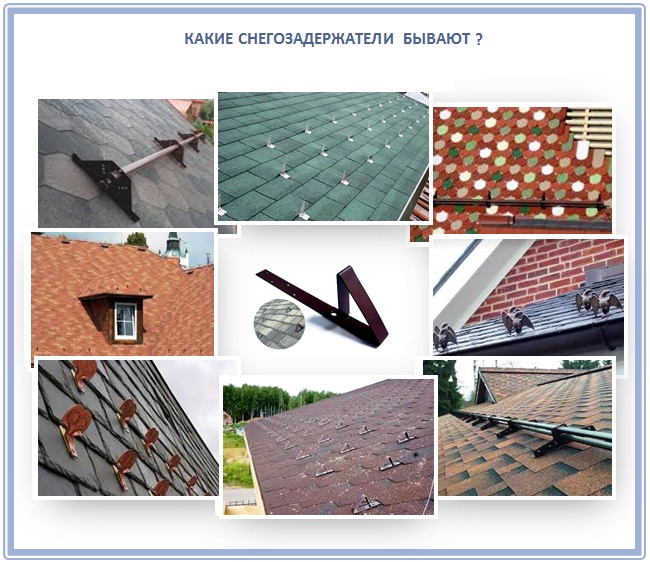
There are several types of systems for metal roofing:
- logs;
- latticed;
- tubular;
- in the form of small metal corners.
These devices differ in the features of the action: barrier and access. And if the latter are used primarily to keep snow on objects with a small height, then the latter - on high-rise buildings. Installation of snow-holders on the roof of the metal does not represent anything complicated, provided a responsible approach to work. Preliminary it is necessary to calculate the snow load on the base of the roof.
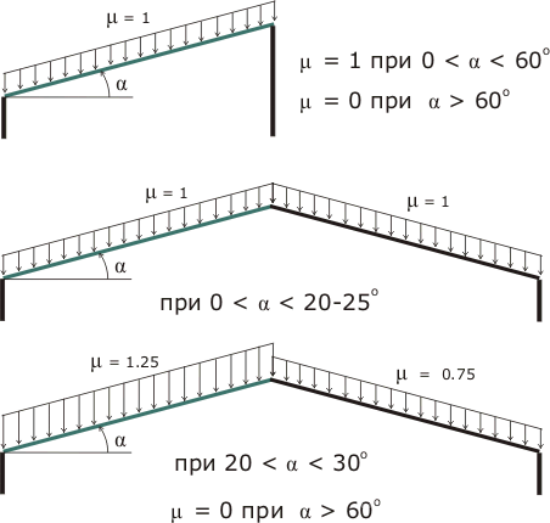
Specialists emphasize the fact that to install metal components of the construction with their own hands must be extremely accurate, observing the prescriptions. The task of primary importance is to calculate the load from precipitation on the roof. To do this, you can use the following relationship:
- Q - the value of the snow load;
- S is the coefficient denoting the correction, in which the slope of the roof is taken into account (≥60 ° - the angle is not taken into account, since snow is swept away and falling from such a roof, from 25-60 ° - 0.7, ≥25 ° - 1);
- G - weight of precipitation (for snow a special table is provided).
For each region of our country there is a map with a snow cover zone.

The main varieties of snow holders
One of the oldest mechanisms for fighting snow and ice on the roof. For the first time logs began to be installed in small alpine houses, but even in the 21st century they lose relevance. Their key advantage is high reliability and availability. This is not surprising, since the pipe copes with large loads without problems.
Modern tubular snow holders for metal roofing are realized from metal pipes, while the minimum diameter is 140 mm. As a supporting structure, steel sheets protrude.
Corner structures
![]()
Corner version
As a rule, we are talking about thin steel sheets, coated with polymer protection, leveling the likelihood of corrosion. This is one of the simplest from a constructive point of view snow holders. Despite its availability, corner products effectively protect the lid from snow.
Optimum to fasten snegozaderzhateli on a metal tile on traditional corners or on samorezy. Protective structures are fixed mainly on the upper wave of the sheet.
Lattice solutions
Snegozatderty latticed type are considered the most effective and most in demand in the market. They, in turn, can be "royal" and ordinary. There are no fundamental structural differences between the two types. The division is only conditional. Their fastening is carried out on a similar principle. And the differences are in the complexity of the lattice itself and the supporting elements.
When choosing experts recommend to focus on universal models. Due to high gratings, they provide high safety during operation, both in summer and in winter. Correctly to establish these elements on forces only to experts. In this case, not only workers but also materials will be protected from falling.
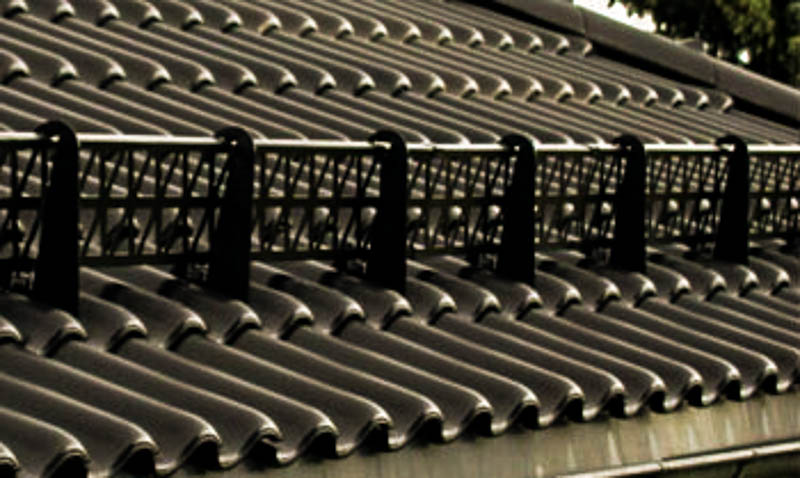
Lattice solutions
In which cases do snowplugs
To install snegozaderzhateli on metal, you need to correctly choose the time for this event. Experts advise to implement their plan during the repair or arrangement of the roof. It is very important to select designs for a particular roofing material. First of all, one should be guided by the structural features of the roof, the climate, and the peculiarities of the terrain.
For soft roofing it is preferable to use snegostoppers, point solutions. In most cases, this is a narrow steel strip, which has a triangular shape. To fix it there are 2-3 self-tapping screws, and for manufacturing it is possible to use galvanized steel.
note!! If the installation is carried out on the finished roof, it is extremely important to use special rubber sealing elements, leveling leaks.

Installation of snow loaders on metal roofing is planned at the stage of roof design, since there is an increase in the snow load on the foundation and rafters as a whole. At the initial stage, they are defined with preferred designs, since some of them require additional conditions. In general, it is quite simple to fasten the elements correctly, it is sufficient to follow a certain sequence of actions.
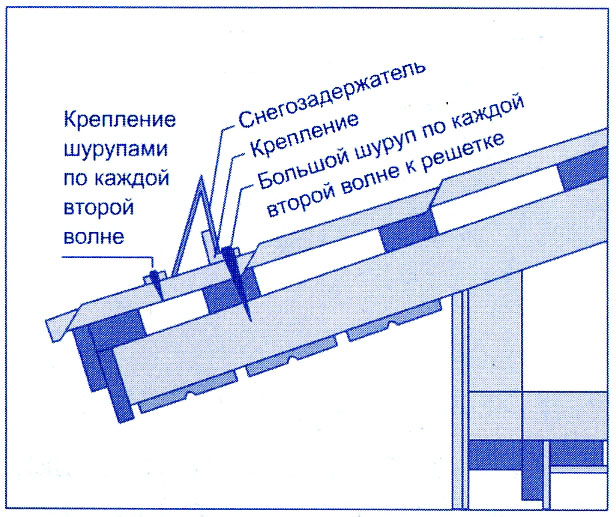
Instructions for installation:
- Determine the location of protective structures on the roof. In most cases, the installation is carried out along the cornice overhang. Experts strongly recommend to equip the first of the tiers above the load-bearing wall of the country house, in order to exclude the additional burden on overhangs.
- Each successive row at a distance of 1.5 to 2 meters. For bugel and angular solutions, the chess order is most preferable, for rows, in the case of lattice, plate and tubular ones.

- In the zone where it is supposed to fasten the snow supports, it is necessary to strengthen the crate with wooden boards.
- After the roofing has been covered with metal roofing, pull the cord and mark the place for mounting the protective elements.
- On the slope with the help of self-tapping screws with special press caps brackets are attached, while between adjacent products a step of 0.5 m is maintained. The number of elements is determined taking into account the roof slope - the more steep it is, the more brackets are required.
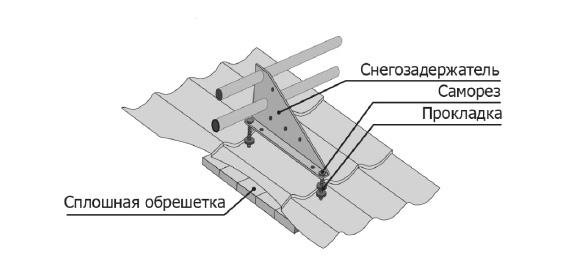
- On the brackets are provided special hooks, into which grids are inserted. On the holders there are small holes where the tubes are placed. The installer should check the reliability of fixing the structure upon completion of work.

Tip!! In the overwhelming majority of cases, only 1 row of tubular structures is sufficient to contain the snow cap on the roof. If in your area a lot of snow falls in winter, and the total length of the 1st ramp is 5 m, you can install a 2-row protection.

Experienced masters advise to adhere to a number of recommendations:
- The snow retention system should be most effective in regions with long and snowy winters. For areas where snow falls rarely, you can limit yourself to cheap solutions.
- Tubular and net products are the best choice for regions with frequent and heavy snowfalls. They not only get rid of problems with snow, but also exclude the possibility of the formation of large icicles.
- From ice and snow it is extremely important to clean both the roof and the most protective structures, as they are predisposed to accumulation of precipitation.
In Western countries, no country house or cottage can be put into operation, if it does not have snow holders. As for domestic realities, we have similar systems set up by prudent owners.
Snow monitors on metal tile video instruction
Snow-holders on metal roofing help protect people from falling snow from above. Every year people get injured by the drop of icicles.
A large snowdrift falling from the roof of a private house can injure a person. Installation of snow-holders on the roof of metal roofing is a good way to avoid this trouble.
Purpose of snow chains
The roof made of metal is beautiful, reliable and durable, but in our climate it has one important drawback. Metal tile is a slippery material, snow does not stick to it.
For this reason, many homeowners install snow-holders on the roof of metal roofing.
Especially dangerous weather, when thaws alternate with frosts. In this case, icicles are formed on the peak.
Even with a small thaw, the snow shaft along with the sharp icicles can collapse down, slipping along the entire roof and gaining a high speed.
Such an avalanche can break the fastening of the gutter, damage the decoration of walls and objects located near the house, including cars.
But the main danger of such avalanches is that they can injure a passing person.
Important: insurance companies may refuse to enter into a home insurance contract if there is no snow-holder on the roof of the metal roof.
Modern snow retention systems have an attractive appearance and do not spoil the roof design.
They meet all the requirements for such systems:
- perfectly combined with the design building;
- prevent the formation of icicles and the fall of snowdrifts;
- help the independent release of the roof from snow;
- protect from falling fragments of the roof itself - this can be actual during hurricane wind or roofing works;
- facilitate manual cleaning of the roof from snow;
- prevent the gutters from blockages.
The principle of operation of all snegozaderzhateley the same - the device is attached to the roof and divides the avalanche of snow drifting down onto the snowdrifts, which do not pose a threat to health and property.
There are designs that simply hold the snow cover on the roof until it melts and drains into the gutters.
In this case, the process of clearing the roof of the snow is imperceptible and does not harm anyone. If you are going to install a snow loader of this type, you need to take into account that the weight of snow falling during the season on the roof may exceed its strength.
There are tables and maps of snow cover zones that help calculate the snow load on the roof for each region.
Snow covers are installed during the installation of the roof, but you can do it later.
It is important to choose a design that is identical in color to the metal tile itself - such details will be virtually invisible.
People who have an artistic taste, have the opportunity to show it by picking snow holders according to the principle of color contrast. Such edging along the perimeter of the roof can become an ornament of the building.
Types of snow chains
The industry produces five varieties of snow-holding systems.
Tubular snow holders for metal roofing are the most popular. They are two parallel tubes installed along the perimeter of the roof at a distance of about 50 centimeters from the edge of the visor.
Tubes are fixed on the roof by triangular details in the place of joining the roof with the supporting wall.
The construction is forbidden to attach to the cornice itself, since in this case, under the pressure of a snow avalanche, not only the snow-holding system, but also a part of the roof, can collapse.
On very wide slopes snegozaderzhateli can be installed in several rows. The tubes are then staggered.

If the house has roof windows, then above them set separate snow holders.
Latticed snow traps are considered the most effective, but they do not look good on small roofs. But for large roofs, latticework is the best option.
Homeowners share trellised snow-holders on ordinary and royal. The principle of operation is the same for both, but the lattice of the latter is more complicated to manufacture.
Latticework is quite high and sturdy - they not only protect snow and tiles from falling from the roof, but they can also keep a person sliding down.
Angle snow holders are a low border of a thin steel corner, fixed horizontally along the cornice.
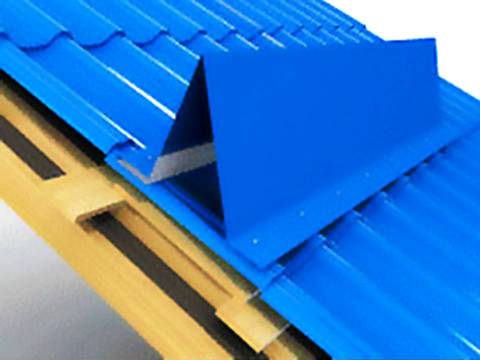
All the details of the structure are covered with polymeric anti-corrosion material, due to which the manufacturer can attach angular snow holders to any color.
The design of such systems is very simple, they are inexpensive, so they can be safely attributed to the budget option. On the metal tile the corners are fixed with screws into the upper wave of the sheet.
Snow-retaining yoke - narrow metal plates, curved in the form of a triangle. Bugheli are unable to effectively divide the avalanche into fragments.
They can only be used as an addition to the main snow loader. Bugles are staggered along the entire slope of the roof. Independently they are able to retain only a small snow layer.
Logs - this is the oldest system for capturing snow, but it is still used. The advantage of this system is exceptional reliability.
A thick pipe, fixed around the perimeter of the roof on metal racks, prevents the convergence of impressive masses of snow, withstanding heavy loads.
Previously, the role of the snow-holder was played by real logs, now they are replaced by metal pipes with a diameter of 14 cm.
Many people are worried about the question whether there is a standard specifying the number and type of snow catchers for roofs made of metal.
The type, fixing scheme and number of snow holders are determined by the project documentation and depend on the snow load of the given region and the roof slope.
Mounting on the roof
Installation of snow covers on metal tiles depends on the type of system.
All models of snegozaderzhateley supplied with instructions for installation, which must be carefully read before proceeding to mount the snow-holders on the metal tile with their own hands.
Installation instructions for tubular snow holders:
- tubes are installed end to end or chess way;
- tubes are installed parallel to the cornice, approximately between 3 and 4 tiles from the end;
- if the length of the ramp is more than 5 meters, then several rows of snow holders should be installed in steps of 3 meters;
- brackets are fixed in the lower part of the wave;
- it is necessary to try, that the holes for fastening were necessary to the crate;
- on the metal tile mark places for future holes and drill the brackets;
- fasten the bracket to the roof with bolts;
- between the bracket and the tile install a rubber gasket;
- between the brackets leave the distance in accordance with the manufacturer's recommendations;
- insert tubes into the holes of the brackets.
Mounting angular snow holders is carried out using self-tapping screws. The fasteners are screwed into the top of the wave - this provides good rigidity.
To strengthen the metal along the corner in the roof drive a number of screws, but already in the lower part of the waves.
This fastening makes it possible to fix the roof with the crate almost tightly, and the falling snow masses will not be able to tear down the metal tile sheets together with the corners.
Installation of trellis snow chains is more difficult, since this design must withstand more imposing loads than tubular and angular.
Latticework, as a rule, is installed on ceramic and natural tiles or on rebated roofs.
If desired, you can install snow-holders on the metal, but this should be taken care of even during the construction of the roof, otherwise the installation of snegozaderzhateley on metal tiles will cost a pretty penny - will have to remove the roofing.
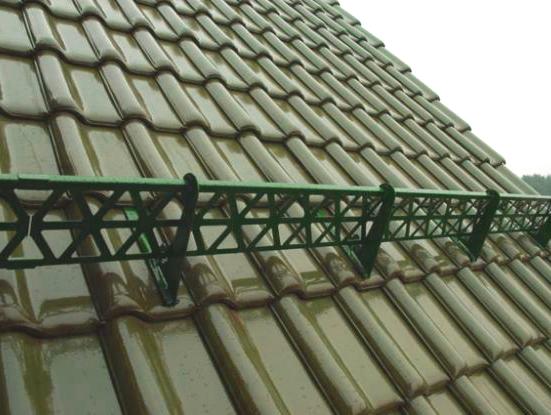
How to fix trellis snow traps? To install them, you have to strengthen the crate with an additional beam.
If this is not possible, then a large number of brackets will be required. The brackets of the snow protective grids are fixed to additional brushes, bolted to the crate.
Each installed bracket clings to one end of the beam and is additionally fixed with metal threaded hardware.
As a result of this method of installation, trellised snow holders can withstand enormous loads.
When the brackets are fixed and the tile is put in place, it will only be necessary to properly install the grille in the fasteners.
How to properly fasten the yoke? Installation is directly on the metal tile itself. Details are placed on the whole surface of the roof in a checkerboard pattern, fixing with roofing screws.
The fasteners are screwed into the lower edges of the sheets, retreating from the edge of 4-5 centimeters.
Very often manufacturers of metal tiles offer snow retention systems of their own design, suitable for their roofing material.
This is the most preferable installation option, since the roofing material will already have the necessary fasteners and holes.
Bugels and other elements will only be fixed on the ground, specially provided for the installation of snegozaderzhateley.
Manufacture by own hands
If there is a desire, then it is possible to make snow holders independently. For tubulars, sheet steel and metal pipes are required.
It is easiest to make angular snow holders, since they do not require brackets. Corners arching out of thin steel. It is important that the strip is bent evenly and at the right angle.
Point snegozaderzhateli or yoke are made of narrow steel stripes, bending one edge with a triangle.
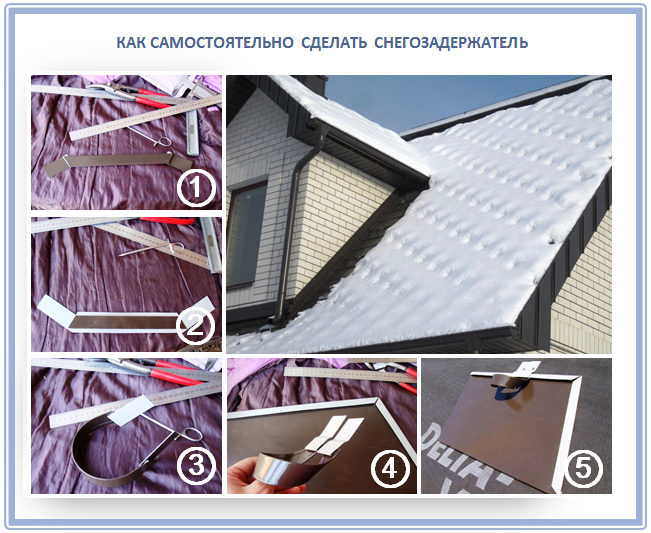
Having at hand a Bulgarian and a welding machine, it is possible to make even trellised snow traps. All the details of this design - brackets and grilles - are made of sheet steel and rod, which can be bought at the nearest metal warehouse.
A proven version of self-made snow-holders is called a "grater". They are teeth that create obstacles along the entire plane of the roof for the sliding of snow.
Teeth - can be made from any material, including plastic and wood. But it is easiest to work with thin steel - it can be bent and twisted in any direction.
"Graters" are so popular in the private sector that from time to time small businesses are setting up their industrial production. You can make them in two or three days.
There are dozens of options for self-made snegozaderzhateley for metal. Inventing, making and fixing on the roof of the catcher own design, you need to pay special attention to the strength of fastening parts to the roof.
Mount snegozaderzhateli need not to the roofing material, but to a more solid layer of the roofing pie: to the base, rafters or crate.
Otherwise, instead of protecting against snow, snow holders will themselves pose a threat, as they can be pulled out together with metal roofing during the snow avalanche.
Now you know how to choose and how to install snow blowers, and will be able to protect your home from dangerous avalanches.
Russian winter is particularly severe, in view of which owners of private houses each year receive certain losses - and all because of the snow. The white hat on the house only looks seemingly easy and harmless, even artistic, but in fact without proper actions is a source of danger. Breaking snow can not only damage the garden buildings, break a fence or kill a dog, but also damage a person. Therefore, the current SNiP provides for the roof safety system, which necessarily includes snow holders on metal roofing as one of the particularly slippery roofing coatings. Do you have such a roof? Install them necessarily!
What is dangerous avalanche convergence of snow?
Not for nothing every spring in periodicals you can find reports of problems due to the convergence of ice and snow masses from the roofs, both private and multi-apartment buildings. Usually the consequences of the avalanche-like convergence of snow are not particularly tragic, but there is always damage from them. That's why snow on the roof needs to be given special attention, and not only in terms of cleaning it.
After all, you are not always at home, you have business trips, holidays and, after all, an ordinary person is not immune from getting into a hospital. Where is better to put special equipment or fencing elements, which, for a minute, are provided by modern building codes and rules. Your roof is made of metal? You are at risk!
Judge for yourself:
Are snowblocks required for metal tiles?
Literally, five years ago, snow floaters in the domestic market were almost not heard. At that time, some snow throwers to install on the roof offered only large developers, although in Western countries, such elements have long been considered mandatory for the installation of any pitched roofs.
In these countries, a house that was built without snow-restraints is considered unfinished and does not comply with the law on safety. This can not even be insured. Think about it, because the average thickness of the snow cover on the roofs in the Russian climate is one and a half meters!
Let's explain in more detail. If you once had the good fortune to rake white and fluffy snow at the gate, then surely you know how difficult it really is. And therefore you understand well how dangerous it is to drop a thick snow layer on someone's head or on your favorite car. Yes, and often the roof itself does not withstand such loads, which destroys the integrity of its coverage and leakage occurs. Let's put it this way: in Russia it is necessary to install snow covers on any pitched roof, especially on metal roofing.
Despite all the advantages of this modern roofing material, the metal tile has a number of minuses. So, it has a high thermal conductivity, it quickly heats up during the thaw period and the snow on it melts as quickly. And at night, at the first cold snap, it freezes quickly - in the morning you get ready ice blocks. And the main danger is that an avalanche of snow and ice from such a roof can occur at any time.
Snow carriers themselves, together with roofing bridges, stairs, parapets and fences make up a roof safety system. Due to their durability, work on the roof itself becomes safer, because the standard snow holder is able to withstand pressures from 70 to 300 kilograms. Two hares - one installation!
Types of snow chains in function
And now let's understand what exactly the modern market offers from this series. Thus, some types of modern snow-holders have their specific functions:
- the first to partially skip the snow, in small quantities;
- others detain him completely and are called snobarriers;
- the third type of snow-holder is intended only for a small increase in the friction of the existing roofing. As you guessed, in order to reduce the speed of snow movement down. These are usually placed only on soft roofs.
And in each case, the metal tile needs its specific kind of snow-holders. Let us explain in more detail the example. So, according to official data, the snow cap of roofs in the territory of the central region of Russia is able to reach several tens of tons on average per building. Therefore, in such localities there is no reason to put standard snow chains - here you need those that can prevent partial snowfall, and partially will miss it.
Why such? The fact is that if there is too much snow on the roof, it creates a strong pressure on the rafter system, and when it melts, it causes even more problems. Therefore, it makes sense to reduce its volume, while not getting rid of it completely. And of the partially blocking snow, the most popular are snow-plate holders, lattice and tubular.
In other cases, when snowfalls in the area do not cause special problems, it is more rational to put snowshoes or teeth. Such a uniform distribution of the snow cap over the entire surface of the roof and maintain the integrity of its construction.
Types of snow chains in form and aesthetics
Modern snow holders, in addition to their functions, also differ in form and design. And for this moment is of great importance. All because of the profiling: not every snegozaderzhatel, which can easily be mounted on a flat seam roof, you can adapt to the waves or between them. But you can not attach it to roofing only.
Snow-barrier systems: keep as much as possible
Snegozaderzhateli-snegostopory found on the roofs of metal more often. Since ancient times, in countries with generous snow, simple logs on hooks have been used (today too, but more for decorative purposes), but today in mass production - only their metal counterparts.
Their main task is to keep as much snow as possible on the roof, and let it fall as low as possible, where the pedestrian zone is located and the car is put. But they are suitable only for those roofs, the angle of inclination of which does not exceed 30 degrees.
Snow-holders-laths: light version
Lamellar, or angular snegozaderzhateli - this is the most affordable and simple in its design snegostoppory. They are also called snowballs. These are long bars that are bent in the form of a triangle. As a rule, such products are included in the standard roofing assortment already with finished metal tiles. Naturally, they do not possess significant strength, and are limited to the overall height of the roofing itself. And this corner is fixed on the metal roof with three roofing bolts.
Angle snow holders are produced, as well as point ones, of which we spoke above, from the same roofing material as metal roofing, and also differ in efficiency and high efficiency. Although most often on the roof of the metal tiles are installed exactly angular snow-holders.
Note that if we are talking about metal, then lamellar and angular snegozaderzhateli install on it is quite difficult. The fact that the metal has a wavy profile, so it is possible to nail such only in the upper part of the wave, and it is far from the crate. And if the snow holders are not fastened directly to the crate, in especially snowy winters with the convergence of the snow masses, it will simply be ripped out of them directly from the roof covering, and imagine how much repair you will be facing.
Tubular snow holders: for special loads
Modern tubular snow holders are a solid prefabricated structure of long pipes and support brackets. They are usually made of aluminum or galvanized steel, with a protective polymer coating. The diameter of such pipes varies from 20 to 35 mm, and the pipe walls have a thickness of about 1.5 mm.
Tubular snow holders are usually installed 3 meters long, solid line, on the second wave from the eaves. They are better than all existing snow-blocking systems to prevent the avalanche of snow, without breaking, and without bending under its weight.
Point systems: for uniform distribution of snow
A fairly new type of snow-holders for a roof made of metal tiles are point-like. We are talking about the so-called snegostoporah. It is recommended to install from 5 to 8 snowshoes per each square meter, supplementing them with a snow-retaining grate. Their main task is to uniformly distribute the snow and its pressure on the structure of the roof. Secondary - to serve as some supports, on which you can rely on your feet during roofing, and you do not have to step on the fragile waves of metal.
For each type of roof, snowshoes are made of their own shape, and with their own bracket. Therefore, never buy for metal tiles those point snow holders that originally came, for example, for a soft roof.
"Horseshoes" for metal
More recently, the Russian market appeared snegostopory, which are designed specifically for the roof of metal and are made by the method of cold forming.
They have a curved appearance, which repeats the radius of the standard wave, and are perfectly attached to almost any part of such a roof. Thanks to this innovative technical solution, the problem of fixing snow-holders to profiled roofs in the sphere of their fastening and aesthetic appearance is completely solved. The fastening points of such elements must be treated with polyurethane sealant.
Such snegozaderzhateli have more advantages in the particular case with metal roofing, than angular ones. The fact is that these snowshoes have more anchorages (four, if more precisely), and they themselves are much smaller. Yes, and in the aesthetic terms, such roof elements benefit, remaining less visible.
Polycarbonate "teeth"
But this is already a novelty of the market:
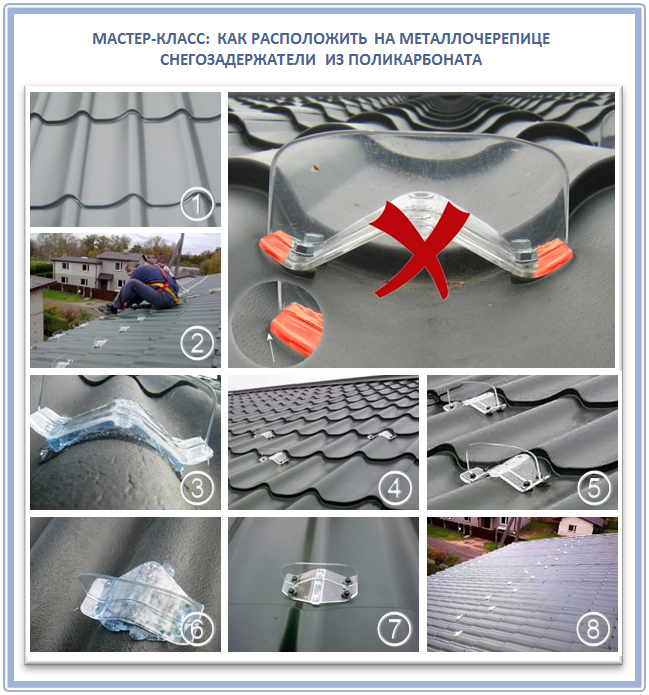
What calculations need to be made in advance?
Before you fix the snow-holders on the metal, make sure to design the location of the snow-holders on the roof. What for? This is necessary in order that in the future the bracket that you installed does not happen to be in those places where there are actually no lath bays, but you have already drilled a hole and now you think what to do with it.
Next, before installing the snow-holders on the metal, you need to think through all the points and take all the data into account. After all, from the competent installation of snegozaderzhateley directly depends on their longevity and functionality. Therefore, it is necessary to calculate the required quantity in accordance with the SNiPs 2.0.10.07.85 for such specific stages:
- Slope of the roof. To obtain such data, use a conventional protractor or apply special formulas. If the roof slopes have a slope of more than 15 degrees, it means that the future snow loaders will be affected by a large load. Therefore, in this case it is better to give preference to a tubular snow holder, which is usually characterized by high strength.
- Type of roofing, namely the features of metal. For all its types, a universal mount of snegozaderzhateley suitable, but if your roof is laid metal "Monterrey", then the metal tile should have a ledge, and thanks to him no longer have to strengthen the crate.
- Color of metal. We recommend that you select the snow holders for the shade of the existing roofing so that the snow-holders themselves are not immediately conspicuous, unless you plan to specifically highlight them. It is also suitable option of roofing elements, which are darker in tone-two.
- Pay attention, that in a complete set with the chosen snow holder should go rubber linings and special roofing screws. It is very important that all parts of the fasteners on the metal roofing are then 100% tight.
- Find out the inherent weather in your area. For example, on a map of snow and wind load.
- Identify number of rows snow holders. This is easiest to do on a special table, which indicates your snow region, the angle of the roof and the distance between the brackets.
Your main task in the calculation of snow holders for your roof is to evenly distribute the load on these roofing elements and the entire truss system. And remember, the brackets can not be mounted close to the overhang of the roof, in this respect there are strict rules:
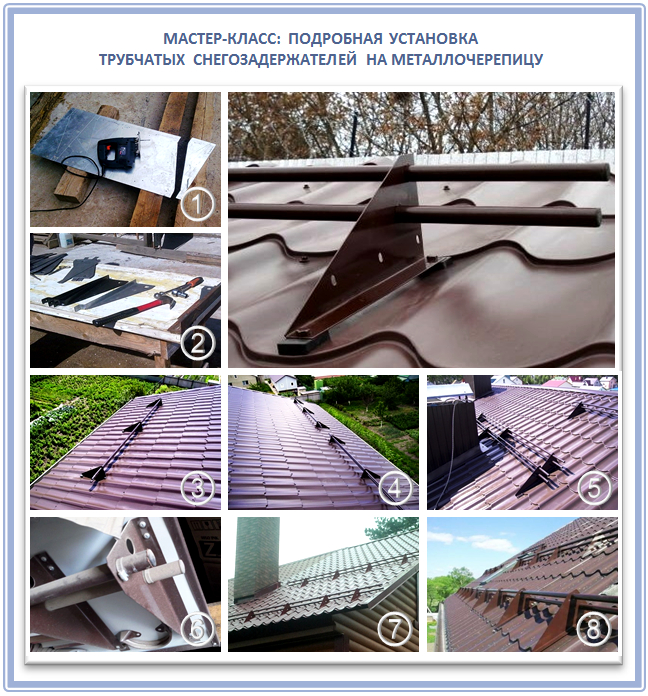
How to properly install snegozaderzhateli?
In the case of metal, it is more reliable to mount snow covers, as well as any other roofing security elements, even at the stage of construction of such a roof:
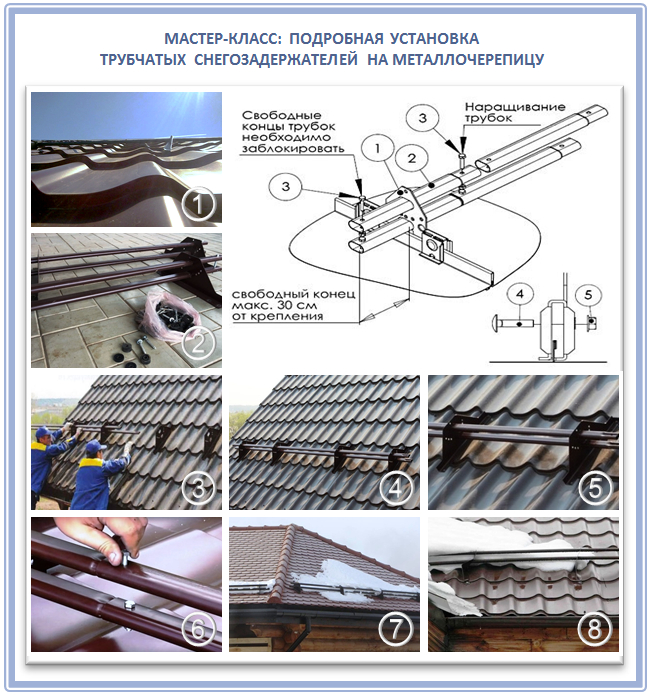
But even if you do not, you will find that the installation of snow covers on the roof of the metal roof is a pleasant job. The only difficulty is to screw the roofing screws into the metal roof, and then seal them properly.
The simplest way is to seal the hole from the roofing screw with a modern silicone sealant, the heat resistance of which is in the range from -50 ° C to + 180 ° C. As you understand, even in severe Russian latitudes there are seldom more severe climatic conditions.
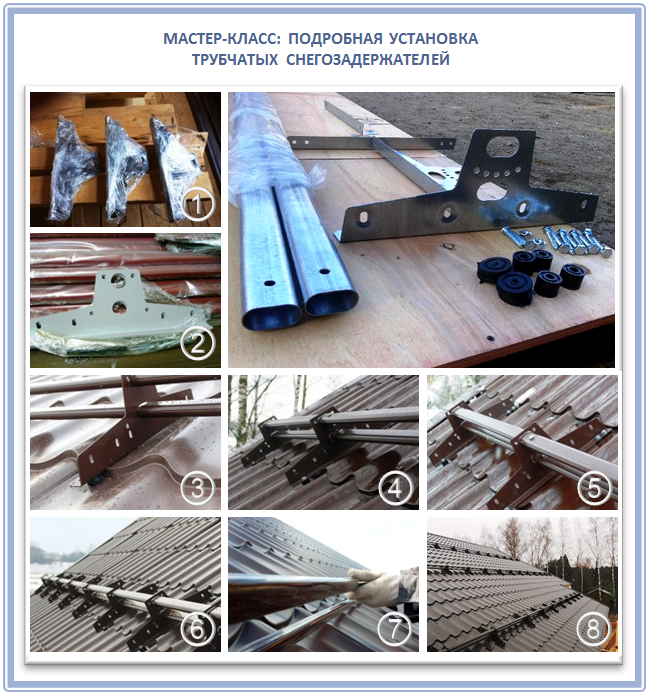
The installation of snegozaderzhateley itself in such specific steps:
- Step 1. Installation of snowplugs, as a rule, begins with the definition of the installation site. If we are talking about metal, then this is the area of the first or second wave from the eaves. The main thing is that snow covers are located above the bearing wall, in order to evenly distribute the load. Install snegozaderzhateli can be on the entire perimeter of the roof, and selectively, in the right places.
- Step 2. Supports are fixed to the roof with the help of hardware, which comes in a set of 2 pieces per one support. And it is important that the hardware fall into the rafters or at least in the roof crate. Otherwise, with a large convergence of snow, the catchers can not withstand the loads, and they will descend together with the avalanche.
- Step 3. Once the Snow Holders are installed, they insert tubes. The tubes are connected to each other and are built up to the required length, and their joint is fixed by screws. From the extreme supports to the ends of the tubes the distance should be 15-20 centimeters. As a result, the total step of the installation should not exceed 70 centimeters.
The correct installation of snow covers on the metal tiles ensures a long service life of these elements!
Here is another such process in detail:
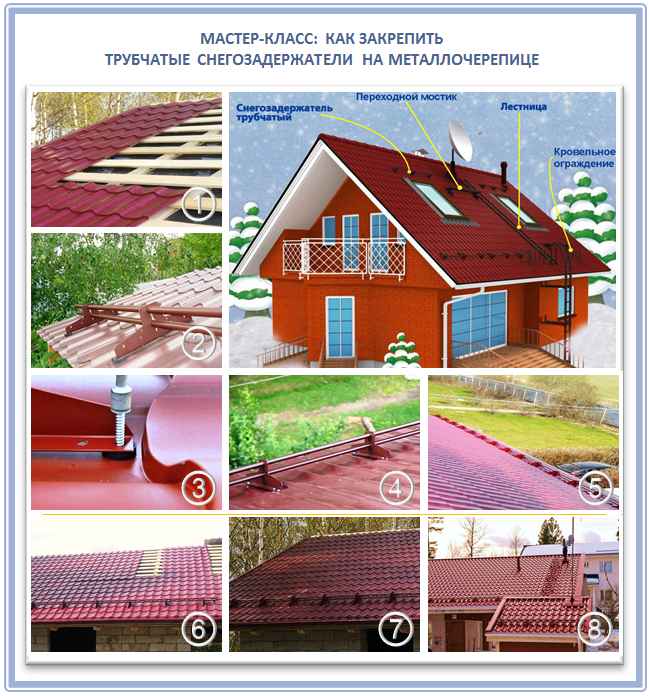
And a more detailed video lesson from one of the producers of such snegozaderzhateley:
Popular questions and error analysis
And now we will discuss with you what can not be done when installing snow loaders on the roof of metal. Listen, these are valuable tips.
Mistake # 1. Why tear off the brackets?
If you have heard about how the brackets broke with snow, there may be several reasons:
- The snow load on the roof is incorrectly distributed.
- Wrong mounting was performed.
- Screws screwed only in the coating, or did not provide an additional bar.
- On a long slope set only one row of snow holders.
Yes, metal in terms of installation of roofing elements - the most capricious coating. Here, indeed, the waves do not allow you to easily establish the same bar, but still in no case can be installed only in metal.
Mistake # 2. Where do the leaks come from?
Consider also such a moment. During mounting of metal tile sheets, the screw is screwed into the end of the wave. And, to remove from it rainwater and garbage, it must be protected with a simple EPDM-gasket.
The longevity of such a rubber is much lower than that of the metal itself, and in 5-10 years at this point it will simply be proresh to get water inside the roofing cake. Therefore, the only way out is to process such joints with additional sealants, or use tubular snow holders, and only at the cornice.
Mistake # 3. Why does the fastening fly out?
Another mistake is the small removal of the snow-retaining element beyond the support, which, with the slightest lateral shift, can lead to the flight of the entire tube or grate from the fastening. The optimal distance is 15-20 centimeters, where the element extends beyond the extreme part of the support.
Mistake # 4. What causes deformation of the supports?
It is also impossible to install only the supports, without the snow-retaining elements themselves. The fact is that the supports are designed only for loads in the direction from the ramp, and if horizontal elements in the form of logs or tubes are absent, then the snow pressure can sometimes be lateral. Especially in the area of the mountains on complex roofs. And all this will damage the supports. The insufficient number of hardware and their short lengths also leads to problems.
Mistake # 5. When does the snow break through the fence?
Another common mistake is the poor attachment of the connecting elements between the grids or pipes, or their complete absence. There is a big risk that in places where the connection is weak or absent, a snowball will break through and it will bend the accompanying roofing elements.
Mistake # 6. If snegozaderzhateli failed?
And, finally, the last mistake, if the installation of snegozaderzhateley made on a too sparse scheme, on each of the supports already have a larger load. This will invariably damage the support itself and the roof covering that is underneath it.
The main reason for such errors is the wrong calculation of the installation of the snow retention system, erection errors and unreasonable desire to save. If the console is exposed to too much snow mass, the extreme supports are always damaged, and because of them, a chain reaction may even occur along the entire line.
Here is a good and detailed video-lesson, how to install modern snow loaders on such a roof as metal tile:
And finally, valuable advice: do not forget that during the first year of operation of snegozaderzhateley it is necessary to check the tension of bolts of brackets approximately every 4 months. After this, the test can be carried out only once a year, during a routine inspection of the entire roof.
That's why it is more convenient to install snow covers in the first year of roof operation, since metal tile all the same provides for frequent inspection of all its fastenings at the first time, and it is more convenient to combine all these tasks in time. Good luck!
